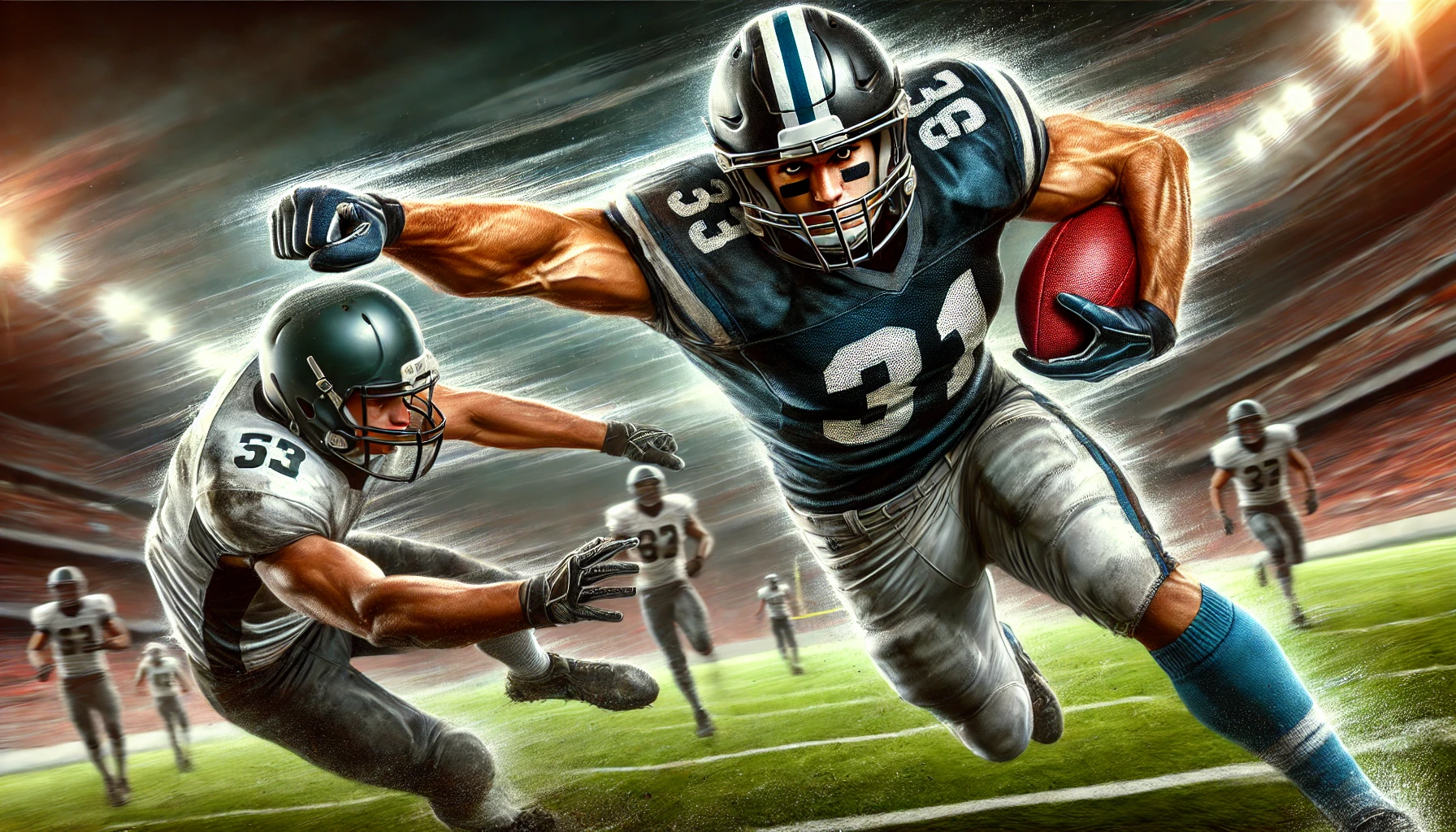Unleashing the Speed Within
When it comes to football, speed is one of the most valuable assets a player can possess. Whether you’re a wide receiver racing to catch a deep pass, a running back trying to break through the defense, or a linebacker closing in on a ball carrier, the ability to accelerate quickly and sprint at full speed can make all the difference between success and failure on the field. Sprint speed and acceleration are crucial for every position, and improving these abilities can significantly elevate your football performance.
The key to improving sprint speed and acceleration lies in training specifically designed to enhance explosive power, stride mechanics, and overall athleticism. With the right approach, athletes can increase their top-end speed and, more importantly, their ability to accelerate from a standstill or slow pace. In this article, we’ll discuss the importance of sprint speed and acceleration, the drills used to test these skills, and the best exercises for improving them to take your game to the next level.
Why Sprint Speed and Acceleration Matter in Football
Football is a fast-paced sport that requires athletes to move quickly and explosively in different directions. Sprint speed, however, is not just about how fast you can run; it’s about how quickly you can get from point A to point B. Whether it’s sprinting for a touchdown, chasing down an opponent, or quickly positioning yourself for a pass, speed and acceleration are key to maintaining a competitive edge.
Sprint speed refers to the maximum velocity a player can reach, while acceleration is the ability to reach that top speed as quickly as possible. Both are critical components of performance on the field, but acceleration is often more important than sheer sprinting speed. In football, most plays start from a stop or slow pace, and the ability to accelerate out of the gate can determine whether you gain or lose yards.
For example, wide receivers need excellent acceleration to beat defenders off the line of scrimmage, while running backs need to quickly change speeds to evade tacklers. Defensive players, on the other hand, rely on acceleration to close the distance between themselves and the ball carrier. The more powerful your acceleration and faster your top-end speed, the more effective you’ll be in your position.
NFL Combine Drills and What They Test
Every year, NFL hopefuls go through the NFL Combine, where their athleticism is put to the test in a series of drills designed to measure their physical capabilities. Two of the most important drills for measuring speed and acceleration are the 40-yard dash and the 3-cone drill. These tests provide insight into a player’s explosive power, agility, and ability to change direction quickly.
The 40-yard dash is perhaps the most well-known test of speed and acceleration. This drill measures how quickly a player can accelerate from a standing start to full speed over a distance of 40 yards. For positions like running back, wide receiver, or defensive back, improving your time in the 40-yard dash is essential for showcasing your top-end speed and explosive power.
To improve your performance in the 40-yard dash, it’s crucial to focus on both your start and your sprint mechanics. A strong and explosive start allows you to get off the line quickly, while maintaining good sprinting form will help you achieve your top speed. Exercises such as box jumps, sled pushes, and hill sprints can help you develop the leg strength and explosive power needed to improve your time.
The 3-cone drill, also known as the L-drill, is another crucial test that evaluates a player’s agility and change of direction. In this drill, the athlete must run in a series of sharp turns around cones set in a zigzag pattern, testing their ability to change direction quickly while maintaining control and balance. This drill is often used to assess wide receivers, running backs, and defensive backs, as agility and quickness are critical for these positions.
To improve in the 3-cone drill, players need to focus on agility training and lateral movements. Exercises such as ladder drills, shuttle runs, and cone drills will help players develop the ability to pivot, plant, and accelerate in various directions without losing speed or balance.
Exercises to Improve Sprint Speed and Acceleration
Improving sprint speed and acceleration requires a combination of explosive power training, sprint mechanics drills, and conditioning exercises. Below are some of the most effective exercises to help you develop the strength, speed, and agility needed for football:
Sled Pushes and Pulls: Sled pushes and pulls are excellent exercises for building explosive power in the legs, core, and upper body. These movements closely mimic the explosive acceleration needed in football, and by increasing resistance with weighted sleds, you can build strength and power in the muscles used during a sprint. By focusing on the forward lean and driving through your legs, sled pushes can enhance both your speed and acceleration.
Hill Sprints: Sprinting up an incline builds strength and power in the lower body, particularly in the glutes, hamstrings, and calves. Hill sprints increase your ability to drive your legs powerfully and help improve your sprint start. These sprints also help develop acceleration by training your muscles to produce force in a short burst.
Plyometric Training: Plyometrics involve explosive, high-intensity movements that help develop power, speed, and acceleration. Box jumps, depth jumps, and bounding are all excellent exercises for building explosive lower body strength. These movements enhance the muscles’ ability to stretch and contract quickly, which is key for both acceleration and top speed. Plyometric training improves the force output in each stride, giving players the ability to burst past defenders and close gaps quickly.
Resisted Sprints: Adding resistance to your sprints, either through parachutes, sleds, or resistance bands, can improve your acceleration and sprint mechanics. By forcing the body to work harder during the sprint, resisted sprints build strength and power in the legs and glutes, which directly translate to faster sprints and quicker starts. Make sure to perform these sprints in intervals, alternating between high resistance and lighter sprints for optimal results.
Acceleration Drills: Practicing acceleration starts is vital for football players, especially for those who need to burst out of the gate as quickly as possible. Perform short sprints (10-20 yards) with a focus on quick starts, explosive movements, and proper mechanics. Work on driving through your legs, keeping a low body position, and using your arms for balance and power. These acceleration drills improve reaction time and teach the body to transition from a stop to full speed as quickly as possible.
Agility Drills: Agility is crucial for changing direction quickly and maintaining control while accelerating. The pro-agility drill (5-10-5 shuttle), T-drill, and cone drills are all great ways to improve footwork, lateral movement, and quickness. The goal of these drills is to maintain high speed while quickly shifting direction without losing balance or momentum. Agility training improves the ability to decelerate and re-accelerate quickly, which is necessary for making quick cuts, dodging tackles, or following a play.
Sprint Technique Drills: To improve your sprint speed, it’s essential to refine your running technique. A strong sprinting form leads to more efficient energy use and faster times. Work on keeping your body tall, with an upright posture, and engage your core for stability. Keep your knees high and drive through the balls of your feet. Sprint technique drills, such as high knees, butt kicks, and A-skips, help improve your form, ensuring that you run as efficiently as possible.
The Role of Flexibility and Mobility in Sprinting
While strength and power are essential for sprinting, flexibility and mobility play an equally important role. Flexible muscles and joints allow for a longer stride length and quicker recovery time between steps, which can improve both speed and acceleration. Tight muscles can limit stride length and prevent the muscles from fully extending, reducing sprint efficiency.
Incorporating dynamic stretching into your warm-up routine can help prepare the muscles for the explosive movements required during sprinting. Dynamic stretches such as leg swings, lunges, and hip openers target the hip flexors, hamstrings, quads, and calves, which are all crucial for sprinting. Stretching the hip flexors, in particular, improves stride length and helps you drive your legs more effectively during sprints.
Foam rolling is also an excellent tool for improving mobility. By targeting tight areas in the muscles and fascia, foam rolling helps release tension and improve the range of motion in the legs, hips, and lower back. A regular foam rolling routine will help prevent stiffness and improve flexibility, allowing you to perform sprint drills more effectively.
Recovery and Nutrition: Maximizing Gains from Sprint Training
As with any demanding physical activity, recovery is key to maximizing the benefits of sprint training. Overworking the muscles without proper rest can lead to fatigue, injury, and a decrease in performance. Proper recovery techniques, such as rest days, active recovery, and stretching, allow the muscles to repair and grow stronger.
Nutrition plays a crucial role in both performance and recovery. Fueling your body with the right nutrients before and after sprint training ensures that your muscles have the energy they need to perform and recover. Carbohydrates provide the energy required for intense sprinting, while protein helps rebuild and repair muscle tissue. Healthy fats support joint health and reduce inflammation.
Hydration is also essential for optimal performance. Dehydrated muscles are more prone to cramping and fatigue, so it’s important to maintain proper fluid levels before, during, and after training. Drink water throughout the day and consider using sports drinks that replenish electrolytes during intense sessions.
The Fast Track to Success: Consistency and Focus
Improving sprint speed and acceleration is not an overnight process. It requires dedication, consistency, and a commitment to focused training. NFL athletes dedicate themselves to building speed and acceleration, using a variety of drills, strength training, and agility exercises to enhance their performance on the field.
To see progress, focus on consistent training, refining your technique, and gradually increasing intensity. Keep challenging yourself, pushing through fatigue, and maintaining a positive attitude. With time, dedication, and the right approach, your sprint speed and acceleration will improve, giving you the competitive edge on the field.
Ready to Accelerate: Take Your Game to the Next Level
Improving sprint speed and acceleration is key for any football player looking to elevate their game. Whether you want to break away for a long touchdown, evade tackles, or close the gap on defense, increasing your ability to accelerate and sprint faster will give you a huge advantage. By incorporating targeted sprint training, agility drills, strength exercises, and flexibility work into your routine, you’ll be on your way to becoming a faster, more explosive player on the field. Let your speed and power guide you to success—your next big play is waiting!




